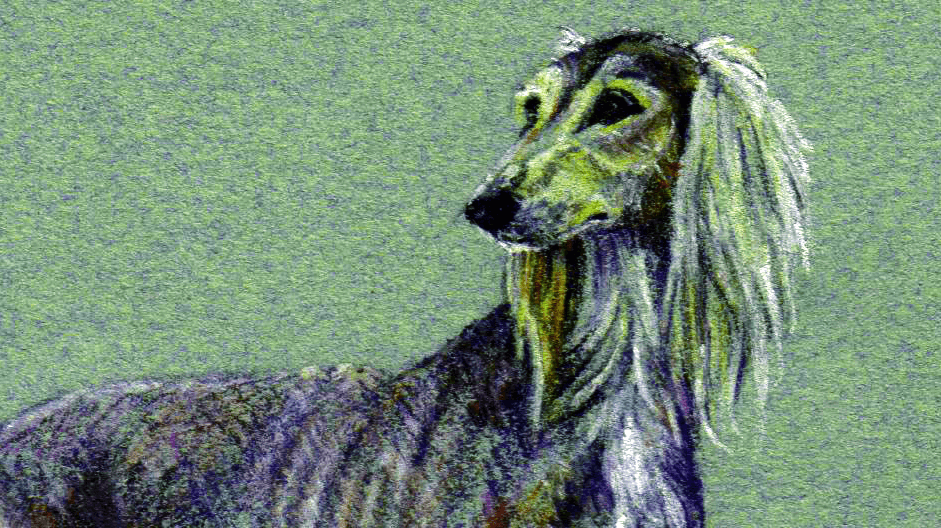Judging Salukis
(This article appeared in the May 2013 Edition of SHOWSIGHT and is reprinted here in memory of Ed and Pat Gilbert who shared a lifetime of devotion to the Saluki.)
The AKC Breed Standard for the Saluki is an excellent Standard for exhibitors, breeders, and judges. This statement, though, is predicated on the person utilizing the Standard having knowledge of the basic original purpose of the breed.
The Saluki Club of America (SCOA) was formed in July 1927. The Saluki was officially recognized by AKC in November 1927. The Saluki Standard has not changed since the SCOA introduced the Standard. With a stable Standard, the breed has resisted the changes of fads and fashions—the breed has stood the test of time.
The essence of the breed is found in the General Appearance paragraph which states: “The whole appearance of this breed should give an impression of grace and symmetry and of great speed and endurance coupled with strength and activity to enable it to kill gazelle or other quarry over deep sand or rocky mountains. The expression should be dignified and gentle with deep, faithful, far-seeing eyes. Dogs should average in height from 23 to 28 inches and bitches may be considerably smaller, this being very typical of the breed.”
There are many styles in the Saluki and they all have breed type. Type is defined by the Standard. Styles are determined on where the breeding stock came from and the individual breeder’s interpretation of the Standard. As long as the style is within the confines of the Standard, it has breed type.
The Saluki has two varieties, Feathered and Smooth—but in the Conformation ring they are not separated by variety and are to be judged on an equal basis. In the Smooth variety, the points should be the same with the exception of the coat, which has no feathering. The writers consider the Smooth Variety more than competitive with the Feathered Variety. Because they look different is no reason to overlook them.
The height/size variation, dogs 23 to 28 inches and bitches may be considerably smaller, is based on where the particular style of Saluki originated. We have seen mature bitches—never in the show ring—as small as 19 inches at the shoulder. The 5-inch size variation in males is the largest size variation of any hound breed. Any dog over 28 inches is no longer a Saluki.
The Saluki is a sighthound and chases and kills the game it pursues. The range of the Saluki was from the southern tip of the Arabian Peninsula, north to Syria, and east to Iraq, Iran, northern India, northern Pakistan, southern Afghanistan, and into China. They were mainly kept by the nomadic tribes of Asia and the Bedouins in the Arabian Peninsula. In southern Arabia, the gazelle is 20 inches tall at the shoulder. The environment is dry and hot, with little water and food. As a result, the tribesman, horses, game, and dogs are small. In Northern Iraq, much of the game is quite large, as there is plenty of vegetation, water, and large game and dogs. The environment in which the Saluki existed, and the game it hunted, determined the conformation and size of the Saluki, or as previously stated, its style.
Some other style differences are due to the feathering. The Standard states that the ears are covered with long, silky hair. In some styles, the feathering is long and covers the entire ear yet the feathering is only on the top portion of the ear and the bottom half of the ear, which is covered by feathering, has real short hair. This is acceptable, just as the ear that is fully coated with long feathering is acceptable. Different lengths of ear feathering exist, varying from just covering the ear to feathering extending four to five inches past the end of the ear leather. The amount of feathering is unimportant.
The Standard is silent on ear set. Ear set can vary from level with the skull down to even with the eye. What is important is that the ear is mobile, meaning the relatively low-set ear can move up to skull level and the relatively high-set ear can move toward the center of the skull.
Prominent eyes detract from the expression, while deep, faithful, far-seeing eyes are large and oval, providing the proper Saluki expression. Eye color is from dark to hazel, which means there can be a very dark eye, a self-colored eye (matching the coat color) or a lighter “bird of prey” eye on a dark- or light-colored dog. All are correct.
The Standard calls for a head long and narrow, with the skull moderately wide between the ears. The skull definition places a limit on the term “narrow.” The Saluki needs to kill the game. Too narrow a head and it will not be able to fulfill the basic original purpose of the breed; to kill gazelle or other quarry. When the head is too wide, the dog loses the impression of grace and great quality, but more importantly, it will aid in reducing its speed and endurance. The dog must be light on his feet and appear agile. They must also be in good running conditioning, with supple muscles and not carrying too much weight. Yet, a too thin dog with every vertebrae and rib showing is not correct either. It’s preferable to see the last two or three ribs (11th thru 13th) and the rest covered.
The Standard calls for teeth strong and level. In the 1800s and early 1900s, a level bite meant that the incisors are aligned in a level plane, not dropped or misaligned. It was not meant to mean that the upper and lower incisors met edge to edge. As the Saluki Standard was drawn up in the early 1900s, level means aligned in a level plane. The term “strong teeth,” based on the basic original function of the breed to kill its quarry, indicates the entire mouth is full and complete, and properly aligned with a strong lower jaw. Based on function, a scissor or pinscher bite is acceptable.
A long, supple, and well-muscled neck and a deep and moderately narrow chest aid the double suspension gallop, enabling the great speed of the Saluki when engaged in pursuing its quarry.
The deep chest provides for plenty of heart and lung room, providing endurance.
The moderately narrow chest permits the shoulder and upper arm to glide along the sides without interference from the chest. This aids both the trot and the double suspension gallop.
The Saluki is a moderately angulated dog, shoulders sloping and stifle moderately bent, as its functioning gait is the double suspension gallop. In the field, it goes from a walk to a reconnaissance gait, into the double suspension gallop. The Saluki requires supple, well-muscled forequarters and hindquarters coupled with a broad back, deep chest, and extremely strong loin. The topline is level, with a slight arch over the loin that provides the power pack during the double suspension gallop. The well-developed, supple first and second thighs provide the galloping and jumping power during the double suspension gallop.
The Saluki requires a good tuck-up, which is implied in the General Appearance paragraph—grace and symmetry and of great speed. Basically, no tuck-up, no speed.
Looking from the front and the side, the forelegs are straight and long from elbow to knee. The Standard does not mention the front pastern. Due to the many styles of Salukis and the terrain they hunted over, the front pasterns vary from upright to a maximum slope of 10 degrees.
The feet of all styles are covered by the Standard: Of moderate length, toes long and well arched, not splayed out, but at the same time not cat-footed; the whole being strong and supple and well feathered between the toes.
Saluki lore states that “well feathered between the toes” protected the feet from the hot burning sand. Okay, then explain the Smooth Saluki’s feet with no feathering between the toes.
The tail is well covered for all styles in the Standard: Long, set on low, and carried naturally in a curve, well feathered on the underside with long silky hair, not bushy. Some Smooths have a slight brush on the underside of the tail.
The coat also is well covered in the Standard for all styles: Smooth and of a soft silky texture, slight feather on the legs, feather at the back of the thighs, and sometimes with slight woolly feather on the thigh and shoulder. When a Saluki is shown, if it has the slight woolly feather on the thigh and shoulder, in most cases, it might be removed prior to the dog entering the show ring. A shine or bloom to the coat is also desired and indicates good health and care.
The Saluki is not a breed of fad or fashion. The breed has lived for centuries, as shown in ancient art, and is still an independent hunter with speed and endurance coupled with strength and activity to enable it to kill gazelle or other quarry over deep sand or rocky mountains.
Judging Salukis consists of a combination of art and science that takes into account the basic original purpose of the breed. It is based on the total impression of grace and symmetry of the entire specimen. Stand back and decide if the dog/s in front of you give all the necessary description to catch your eye both standing and on the move. As the old German saying goes, “Can’t see the forest for the trees.” Please find the forest—the graceful Saluki of ages old.








